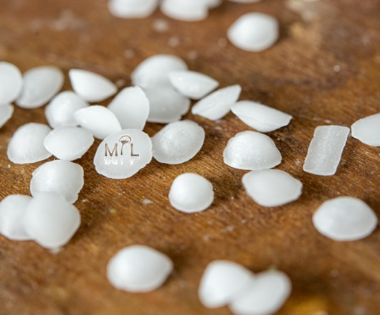





Cetearyl alcohol
In lotions, it is often used at lower concentrations (2–5%) to thicken the lotion and add richness. Because it’s a more potent thickener than something like cocoa butter it gives us the ability to add body to emulsions with just a few percentage points, and without increasing the size of the oil phase. While you could thicken a lotion by including a large amount of something like cocoa butter in the formulation you’d need a lot more cocoa butter to get the same end result, and then your lotion contains a lot of cocoa butter—something you may or may not want. You can also thicken emulsions by increasing the size of the oil phase, but that also makes for heavier, slower absorbing end products. Thickening with fatty thickeners like cetearyl alcohol allows you to create thick, creamy lotions that are also lightweight and fast-absorbing.
Key words:
Cosmetic Materials
Classification:
- Product Description
-
- Commodity name: Cetearyl alcohol
In lotions, it is often used at lower concentrations (2–5%) to thicken the lotion and add richness. Because it’s a more potent thickener than something like cocoa butter it gives us the ability to add body to emulsions with just a few percentage points, and without increasing the size of the oil phase. While you could thicken a lotion by including a large amount of something like cocoa butter in the formulation you’d need a lot more cocoa butter to get the same end result, and then your lotion contains a lot of cocoa butter—something you may or may not want. You can also thicken emulsions by increasing the size of the oil phase, but that also makes for heavier, slower absorbing end products. Thickening with fatty thickeners like cetearyl alcohol allows you to create thick, creamy lotions that are also lightweight and fast-absorbing.
WHAT IS CETEARYL ALCOHOL?
Cetearyl alcohol is a blend of cetyl alcohol and stearyl alcohol—two fatty alcohols. It can come in 50/50 and 30/70 blends; I always use 30/70. Check with your supplier before purchasing so you know what you’re getting; if yours is different from mine you’ll likely notice a difference in the consistency and feel of your finished products, but that will vary.
Cetearyl alcohol melts around 50°C (122°F). For comparison, shea butter melts around 37°C (98.6°F), cocoa butter melts around 34°C (93.2°F), and coconut oil melts around 24°C (75.2°F). It is oil soluble and solid at room temperature—you’ll usually purchase it as smallish white pellets that are visually indistinguishable from ingredients like Polawax and BTMS-50. Make sure you keep your labels straight!
Cetearyl alcohol doesn’t smell like much of anything, and if you keep it reasonably cool it should last at least two years, if not longer.
WHAT DO WE USE CETEARYL ALCOHOL FOR?
Cetearyl alcohol is both a thickener and an emollient, and it’ll do both jobs in any formulation, though the concentrations it’s used at and the overall formulation will obviously come into play as well.
In lotions, it is often used at lower concentrations (2–5%) to thicken the lotion and add richness. Because it’s a more potent thickener than something like cocoa butter it gives us the ability to add body to emulsions with just a few percentage points, and without increasing the size of the oil phase. While you could thicken a lotion by including a large amount of something like cocoa butter in the formulation you’d need a lot more cocoa butter to get the same end result, and then your lotion contains a lot of cocoa butter—something you may or may not want. You can also thicken emulsions by increasing the size of the oil phase, but that also makes for heavier, slower absorbing end products. Thickening with fatty thickeners like cetearyl alcohol allows you to create thick, creamy lotions that are also lightweight and fast-absorbing.
You can also find cetearyl alcohol used in thicker creams as one of the primary emollients; it not only thickens the emulsion, but also works as one of the rich, fatty ingredients that help moisturize and soften the skin. It can be used instead of, or in combination with, butters and oils like shea or sunflower.
In anhydrous projects, cetearyl alcohol works to thicken, harden, and raise melting points in a rich, buttery way. While waxes like beeswax or candelilla wax can also do this, waxes contribute a stiff waxiness to our concoctions that isn’t always desirable. I like cetearyl alcohol as a thickener in wash-off products like conditioner bars and cleansers as it rinses off far better than waxes and has a much nicer skin feel.
Despite having alcohol in its name, cetearyl alcohol is not a “won’t this dry out my skin?!” kind of alcohol. It is not a volatile alcohol like isopropyl (rubbing) alcohol or ethanol (the active ingredient in many alcohol-based hand sanitizers and the intoxicating element in beverages like beer and vodka). It is pretty much the opposite of those sorts of alcohol, really—cetearyl alcohol is solid, non-volatile, and oil-soluble while drying alcohols are liquid, volatile, and water-soluble. So, no need to worry about your skin drying out from cetearyl alcohol!
Cetearyl alcohol is similar to cetyl alcohol and stearic acid in terms of being a non-waxy thickener/hardener, but all three create products with different end feel, so it’s worth understanding their differences so you can understand why you might choose one instead of another. I did one experiment three times, using each thickener—I highly recommend reading through the results so you can start to understand the differences between each ingredient!IS THERE ANYTHING ELSE I SHOULD KNOW?
Beyond the 50/50 70/30 thing, you should know that un-whipped anhydrous products thickened solely with cetearyl alcohol can take on a funny applesauce-y consistency, which is why I sometimes prefer to use a blend of cetyl alcohol and stearic acid in a formulation where it would seem like cetearyl alcohol would work just as well.
Also, you’ll sometimes see cetearyl alcohol sold as an emulsifying wax on its own, or described as an emulsifier. It is not an emulsifier. You’ll find it in both BTMS-25 and Emulsifying Wax NF—both are complete emulsifying waxes, but the cetearyl alcohol is there to stabilize, not emulsify (that’s what the Behentrimonium Methosulfate/Polysorbate 60 are for). If you attempt to use cetearyl alcohol as the sole emulsifier in a formulation that calls for an emulsifier like Emulsifying Wax NF, the formulation will fail.
Packing and shipping
MTL Chemical possess right of autonomy in import and export operation, with products sold to several dozens of countries and regions in North and South America, Europe, Asia, Australia and South Africa, hence enjoying extremely high reputation and popularity on the international stage.

Customer testimonials
Commercial credibility strengthens the basis. Innovation leads to the future development. MTL Chemical always pursue win-win cooperation and provide all customer with professional services and high-quality products.

Customer testimonials
The Company also boasts a team of professional talents engaged in chemical management, production, R&D and trade, among whom technical talents account for 30%. In strict accordance with requirements of ISO9001, ISO14001 and GB/T-28001, the Company has exercised supervision, control and operation over every link of production, with a view to realizing the perfect combination of social responsibility, employee health, environmental protection and product quality. We are looking forward to working together with the people of all circles at home and abroad to seek common development!








Previous article
Next article
Previous article
Next article
ONLINE MESSAGES
Recommended Products

